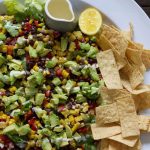There are two compounds in dairy that may be causing this, lactose and milk proteins. It's really important to establish which of these are the trigger for your symptoms as you may not need to remove all dairy.
In this newsletter you'll learn everything you need to know about lactose, including how you can mange lactose intolerance.
- Lactose is a milk sugar. The body produces a digestive enzyme called lactase to break down lactose.
- Lactase is highest after birth. Production then declines during adolescence to 5-10% of original levels. Only 30% of the world’s population retain enough lactase to digest and absorb lactose efficiently during adult life.
- When more lactose is consumed than the available lactase, lactose molecules remain in the intestine undigested, attracting water and causing bloating and diarrhea. These undigested lactose molecules also feed the 'bad' gut bugs which multiply, producing acid and gas making symptoms worse.
- Most people with lactose intolerance can consume up to 6 grams of lactose per day without symptoms. However lactose tolerance varies widely between individuals. You'll need to experiment with your own tolerance level.
Tips to managing lactose intolerance...
- Fermented milk products such as yoghurt and kefir are better tolerated. This is because the live bacteria in these products digest some of the lactose for their own use thereby reducing lactose content.
- Cheese is generally well tolerated as it is low in lactose. Below you'll find a list of dairy products and lactose content.
- Consume dairy with other foods.
- Spread dairy intake over the day.
Most people can manage a lactose intolerance
rather than having to avoid lactose completely.
These cheeses can be enjoyed...
Generally aged cheeses have only trace elements or very small amounts of lactose. Examples of these are cheddar, parmesan, brie and blue cheese. Whereas cheeses such as ricotta and cottage cheese, are higher in lactose.
So you don't need to miss out on cheese nor pizza. You might like to try this delicious healthy cauliflower pizza.

LACTOSE AMOUNTS IN DAIRY

* These foods contain trace amounts of lactose. Data sourced from Food Standards Australia New Zealand. (2022). NUTTAB 2011-13 – Australian Food Composition Tables.
If you've tried low lactose containing foods yet still have problems when consuming dairy then it may not be lactose. It could be the milk proteins. I'll talk more about this in the next newsletter. Please note if you have a dairy allergy (rather than an intolerance) then avoidance of all dairy is necessary.
If you have any questions please let me know.
Thank you for sharing my healthy love of food.
Wendy
Nutritionist & Caterer
0403 861 117
[email protected]
www.acutabovenutrition.com.au





